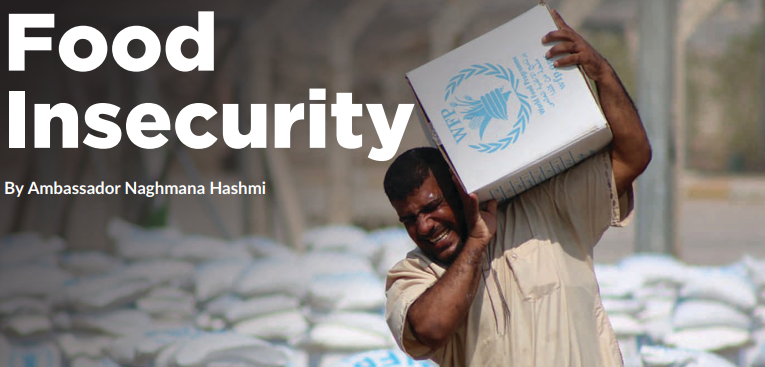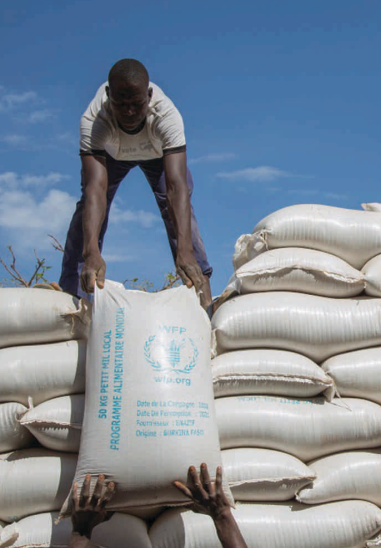
The UN aggregates that approximately one billion people do not get enough to eat on a regular basis. About 16.6% of the world’s population is undernourished and almost 1 in 10 people in the world falls ill as a result of eating contaminated food and 500,000 die every year.
By Ambassador Naghmana Hashmi
In this age of technology and space exploration when some nations are spending billions and reaching for the Moon, the Mars and the vast unknown beyond in search of places habitable for humans, millions of humans are dying of food shortage on the only known habitable planet that we know of to date, our mother earth.
The UN aggregates that approximately one billion people do not get enough to eat on a regular basis. The world produces enough food to feed everyone on the planet, yet 16.6% of the world’s population is undernourished. Almost 1 in 10 people in the world, fall ill as a result of eating contaminated food and 500,000 die every year.
Approximately, 70 percent of the global food supply is produced by small farmers, herders and fishermen, yet they are the most vulnerable to food insecurity. Poverty and hunger are acute among rural populations.
Approximately, 70 percent of the global food supply is produced by small farmers, herders and fishermen, yet they are the most vulnerable to food insecurity. Poverty and hunger are acute among rural populations. Among may other factors, conflict is one of the e main culprits being both the cause and consequence of hunger. In 2020, conflict was the chief driver of hunger for 99.1 million people in 23 countries. Looking at these world hunger figures demonstrates the alarming scale of the global food insecurity.
According to experts, under nourishment causes 45% of all children’s deaths. Each year, 3.1 million children die from hunger-related causes, which include diarrhoea and malnutrition. Every 10 seconds a child dies from hunger. It is estimated that more than 99 million children under the age five are undernourished and underweight. Children experience poor health, low energy levels, and reductions in mental functioning as a result of hunger. According to specialists, rising global food prices will cause 1.5 million more children to be undernourished, making them one of the chief factors contributing to the rise in world hunger.
UN describes under nourishment as the inability to procure enough food for at least one year. Sadly, out of the eight billion people on earth today, one billion people are living in extreme poverty. Extreme poverty wreaks people in several ways. It not only deprives people of necessary food—it also dispossesses them of safe drinking water, sanitation, education, shelter, etc. Increase in demand for food by the continually growing population and under investment in agriculture has resulted in rapid increase in food prices which further heightens food insecurity for those who most need it contributing to food shortages and famine around the world.
Today we are witness to a new phenomenon where we see certain regions in a state of over nutrition while other regions are suffering from under-nutrition – which is extremely unfair and sad. According to the World Food Organization 1/8th of Asia and 1/4th of India face hunger. African Continent is also facing food insecurity of similar dimensions. On the other hand, we see vast wastage of food particularly in the U.S.A and Europe.
It is however, encouraging to see that in France the government has taken action to ensure that food which is not consumed or sold is by law distributed to the poor. Similarly, the restaurants are now obliged to distribute left over food to the needy. But this is only a drop in the ocean. I feel that if other countries in the EU also follow suit, the rest of the developed and developing would surely emulate this course of positive action. It is necessary to act fast because with the global population expected to exceed nine billion by 2050, pressures are bound to continuously increase on existing food systems with ominous implications for food security and safety.
UN describes under nourishment as the inability to procure enough food for at least one year. Sadly, out of the eight billion people on earth today, one billion people are living in extreme poverty. Extreme poverty wreaks people in several ways.
World hunger can be attributed to many causes, including the lack of resources, unequal income distribution, increasing number of natural disasters accentuated by rapid pace of climate change and intrastate and interstate conflicts in various regions of the world, particularly in the under developed and developing countries. In order to rectify the severe food shortage and safety issues and lift people out of poverty, in 2004, 160 countries voted at the United Nations to make food – safe food – a human right rather than a commodity. Unfortunately, this international resolve to tackle the risks to food safety and judicious distribution continue with mounting challenge.
Access to sufficient amounts of safe food is key to sustaining life and promoting good health. Keeping this in mind, the UN marked the World Food Day annually since 2019 with an aim to draw attention and inspire action to help prevent, detect and manage foodborne risks, contributing to food security, human health, economic prosperity, agriculture, market access, tourism and sustainable development.
The World Health Organization (WHO) and the Food and Agriculture Organization of the United Nations (FAO) together facilitate the observance of World Food Safety Day, in collaboration with Member States and other relevant organizations. International Food Day is an opportunity to strengthen efforts to ensure that the food we eat is safe, mainstream the issue of food safety and security in the public agenda and reduce the burden of foodborne diseases globally. Pakistan being a member of the UN also marks the World Food Day.
According to the Pakistan Social and Living Standards Measurement, 16.4 out of every 100 households surveyed during the fiscal year 2019-2020 reported moderate to severe food insecurity. The number was slightly higher than the 15.9pc food-insecure households and these are pre COVID -19 figures which is very worrisome.
I therefore feel that for developing countries like Pakistan who are also vulnerable to climate change, merely marking the World Food Day may not be sufficient. Although it is encouraging to see that in some selected circles of the government and academia the realisation of this important problem is dawning. It was a first but an important step of the government of Pakistan to rename the Ministry of Agriculture as the Ministry of Food Security as it is a much larger and all-encompassing concept. This has gone some way in focussing the attention of the people and the relevant institutions that food safety and food security is an issue that needs urgent attention if Pakistan wants to develop.
However, there is an urgent need to further ensure urgent and effective measures to guarantee food Security and food safety. People, particularly our youth are our greatest asset and key to development and their health and wellbeing is the responsibility of the government in that it should ensure the development of a long term focussed strategy to eliminate the impediments and road blocks that impede the path of achieving food security.
As stated above food insecurity is not just about food shortage in the market. It also signifies the absence of sufficient money to buy food and nutrition. In Pakistan we see a great difference in the level of food insecurity and hunger from one province to another. We see that Punjab does much better then Baluchistan when it comes to food security. Similarly, within a given province there is a big gap between the affluent and poor districts. To top it all there is a major problem in Pakistan for women and children who suffer the most due to lack of food. Due to some backward cultural norms and traditions the adult male member get preference when it comes to distribution of food in poor households.
According to the Pakistan Social and Living Standards Measurement, 16.4 out of every 100 households surveyed during the fiscal year 2019-2020 reported moderate to severe food insecurity. The number was slightly higher than the 15.9pc food-insecure households and these are pre COVID -19 figures which is very worrisome.
There is an urgent need to take focussed action on war footing in Pakistan to ensure we get a handle on the issue of food security and safety. If we stall or drag our feet now, the impact of climate change will further complicate the situation. Unfortunately, the problem is far too complex—and stems from far too many factors—to offer a simple, all-encompassing answer. At the moment, the best that can be done is try to alleviate as many people currently suffering from the effects of hunger as possible. In addition to a range of other efforts, a number of supportive and sustainable agricultural activities can contribute towards addressing food insecurities in Pakistan and achieving our objectives. Some of the steps that the government and concerned ministries and institutions may consider taking on priority are as follows;
- First, education and train people, institutions and organizations involved in food production and distribution. In this regard an interconnected approach that brings academia, citizens, governments, industry and non-governmental organisations together to act on solutions and strategies to ensure food security
- Second, traceability in the food supply chain and development of a broad range of technologies to connect the steps and make food more traceable and, therefore, safer for consumers.
- Third invest and encourage private and FDI in agriculture to make the per acre yield better, invest in grain research, non –toxic fertilizers, facilitate introduction of modern irrigation, planting and harvesting techniques, provision of reasonable loans to the farmers and above all introduce land reforms which is an important lynchpin for the development of agriculture.
- Fourth cattle farming should also be modernized and farmers and organisations enabled to improve dairy and meat production
- Fifth Pakistan is the 5th largest producer of milk yet our finished products are few and not of international standards. Proper policy initiatives, facilitation and training can make this industry prosper.
- Sixth halal meat is also a great and large industry in which our share is very little. Proactive policy intervention and incentives can contribute in a big way towards food security in Pakistan.
- Aquaculture and seafood production can be very effective for greater food safety and sustainability, focusing on improving current practices, and expanding and up scaling for the future.

The writer is former ambassador of Pakistan to china and Brussels




